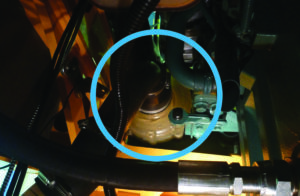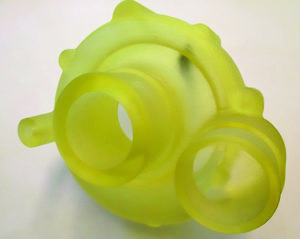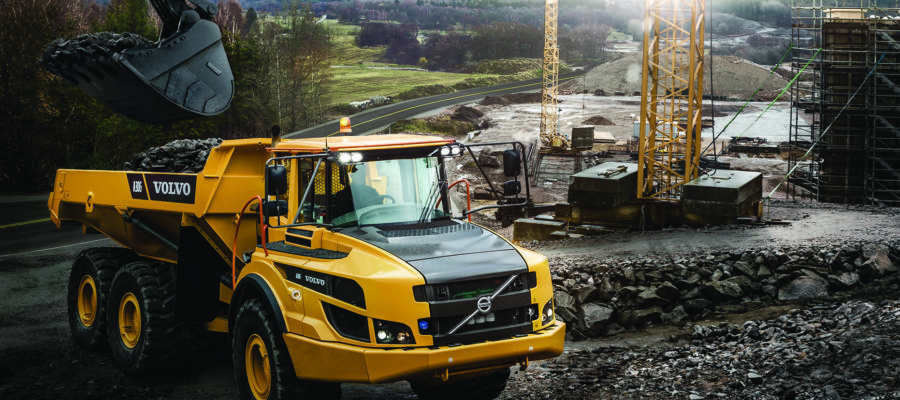Retooling the Engine Using 3D Printing
One of the largest construction equipment manufacturers in the world is Volvo Construction Equipment (VCE). VCE produces a vast product line of equipment including loaders, haulers, excavators, road equipment and compact equipment. Recently, Volvo engineers designed a new water pump housing for their AG30 and A25G articulated haulers. The company’s engineers had used simulation to design the internal flow of passages in the housing but also required a prototype in order to properly test the new designs’ functionality. In the past, Volvo would have used tooling in order to accomplish this. The cost of tooling for a project like this would be around $9,090, with the actual part costing approximately $909. In addition to this, the lead time to produce a prototype through tooling would have taken at least 20 weeks.

Improving Big Engines
Volvo Construction Equipment management instructed their engineering team to cut development costs while also reducing the lead time on big engine projects from 36 months to 24 months. In order to achieve this goal, the engineers looked to additive manufacturing as a benchmark to see if 3D printed parts could withstand functional testing. The requirements for a water pump housing prototype is that it must be able to resist the high pressure and heat of the engine compartment. In order to achieve this goal, VCE, used a Stratasys® Objet Eden260V™ 3D Printer and PolyJet 3D Printing Technology from its Shippensburg, Pennsylvania site. The engineers then used Transparent material, called FullCure® 720, to 3D print the housing piece.
The engineers then mounted nine threaded inserts into the printed part sealed the housing with epoxy resin and hardener in order to stop potential leaking. Then they attached the jacket to a water pump and then mounted the pump to an A30G. In order to evaluate, the engineers took the water pressure and flow measurements from both the water pump with the new housing and the existing water pump. It was a success- the newly designed housing had passed the test. VCE had completed the test much sooner and more cost-effective than what was expected from their prior experience with the use of traditional methods- for both the design and development of the piece, the cost to 3D print the prototype was $770 and it only took two weeks. Thanks to additive manufacturing, VCE is now ready to produce the new part.
Looking to Learn More About Tooling?
Download our guide to learn about the business drivers for adopting 3D printing for production tooling instead o traditionally fabricated tools.

Future Benefits
This project showed the usefulness of incorporating additive manufacturing (3D printing) into VCE’s engine development procedure. Traditionally, every new generation of the engine usually required 15-20 new cast metal parts as well as 12 to 15 profile moldes hoses or each engine. Now, with the use of 3D printing, VCE can make prototypes in approximately 1/10th of the time that was typically required with the use of traditional manufacturing methods- this time adds up to significant savings!
“3D printing will make it possible to build mock-up engine components so the platform and manufacturing teams can provide feedback at a much earlier stage in the development process,” said Jeff Hartman, Product Designer for VCE. “This should reduce risk of errors and the need for changes at all stages of the development process.”
Additive manufacturing also contributes significantly to cost savings. Traditional methods for tooling metal prototypes would cost between $4,400 and $18,000, however, a 3D printed prototype would only cost between $600 and $1,000. In addition to this, molded hose tooling for prototypes cost around $600 and its prototypes run between $60 and $90 – these molded and metal hose prototypes can be replaced with 3D printed prototypes that only cost between $100 and $800. The more prototype iterations that are needed, the more the cost savings.
“VCE is also looking at using 3D printing to produce jigs and fixtures to increase the efficiency of the manufacturing process and digitally manufactured parts to address low-volume part production,” Hartman concluded.
| METHOD | TIME | COST |
| Tooling & Part | 28 Weeks | $10,000 |
| 3d Printing | 2 Weeks | $770 |
Savings |
18 Weeks90% |
$9,23092% |
